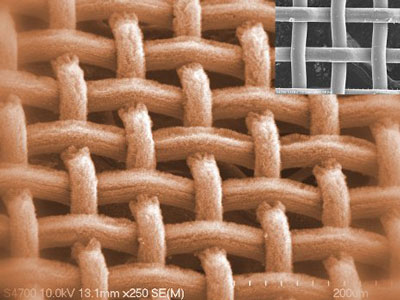| Apr 13, 2011 |
Nanotechnology filter separates water and oil
|
|
(Nanowerk News) Water and oil may not mix, but, like two boxers nearing the end of the final round, they can get awfully tangled up.
|
|
Now, Michigan Technological University scientists Yoke Khin Yap and Jaroslaw Drelich have created a filter that separates the two substances as quickly and cleanly as a ref breaking up a clinch.
|
|
Their fine, stainless steel mesh is coated with carbon nanotubes about 10 microns across. "They have a super-honeycomb structure that repels water," says Yap, an associate professor of physics. "But they like organic stuff, like oil."
|
 |
| A scanning electron microscopy image of the carbon nanotube-coated filter. For comparison, the inset is bare stainless steel mesh.
|
|
The team poured an emulsion of water and gasoline over the filter to test it. Sure enough, the gas dripped through; all but 20 percent of the water stayed put.
|
|
It's not as if you could filter the Gulf of Mexico through the device, Yap cautions. Their prototype is about the size of a quarter. Plus, the water drops can actually clog the spaces between the nanotubes, making it hard for anything to get through. "But the attractive thing is that it's so simple," he says. "It runs by gravitation."
|
|
Drelich, an associate professor of materials science and engineering, thinks the filter has real-world potential. "These were just our first set of experiments," he says. "We could supply electricity to it to heat it up, reducing the oil's viscosity evaporating the water. We could also create a vacuum that would suck oil through the filter to the other side. A good engineering design could get rid of clogging problem."
|
|
Such technology could help purify oil from Canada's tar sands, which is contaminated by traces of corrosive salt water. Or, it could be used to recover oil from the wastewater of ocean-going vessels. It might even be able to scrub the oil inside your car's engine.
|
|
"Our design would be completely novel, because it relies on nanotechnology, and it could be competitive," says Drelich.
|
|
Their work was published in the Feb. 2 edition of the journal Carbon and is funded by the National Science Foundation.
|

